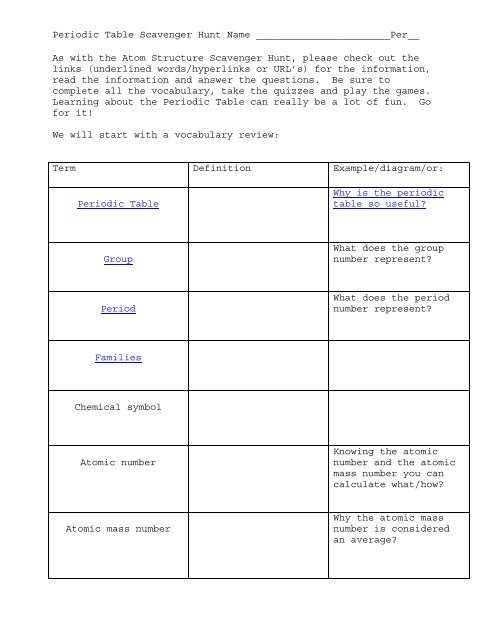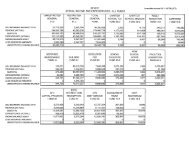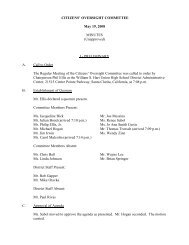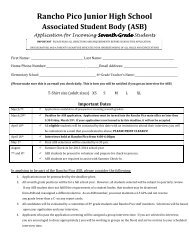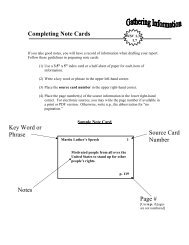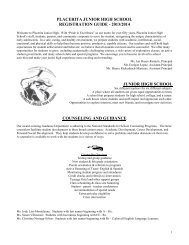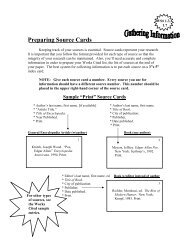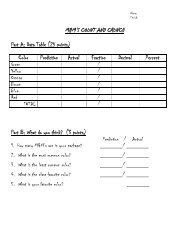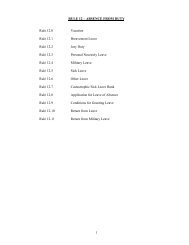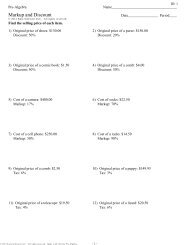Periodic Table Scavenger Hunt Name As with the Atom Structure ...
Periodic Table Scavenger Hunt Name As with the Atom Structure ...
Periodic Table Scavenger Hunt Name As with the Atom Structure ...
Create successful ePaper yourself
Turn your PDF publications into a flip-book with our unique Google optimized e-Paper software.
<strong>Periodic</strong> <strong>Table</strong> <strong>Scavenger</strong> <strong>Hunt</strong> <strong>Name</strong> _______________________Per__<br />
<strong>As</strong> <strong>with</strong> <strong>the</strong> <strong>Atom</strong> <strong>Structure</strong> <strong>Scavenger</strong> <strong>Hunt</strong>, please check out <strong>the</strong><br />
links (underlined words/hyperlinks or URL’s) for <strong>the</strong> information,<br />
read <strong>the</strong> information and answer <strong>the</strong> questions. Be sure to<br />
complete all <strong>the</strong> vocabulary, take <strong>the</strong> quizzes and play <strong>the</strong> games.<br />
Learning about <strong>the</strong> <strong>Periodic</strong> <strong>Table</strong> can really be a lot of fun. Go<br />
for it!<br />
We will start <strong>with</strong> a vocabulary review:<br />
Term Definition Example/diagram/or:<br />
<strong>Periodic</strong> <strong>Table</strong><br />
Why is <strong>the</strong> periodic<br />
table so useful?<br />
Group<br />
What does <strong>the</strong> group<br />
number represent?<br />
Period<br />
What does <strong>the</strong> period<br />
number represent?<br />
Families<br />
Chemical symbol<br />
<strong>Atom</strong>ic number<br />
Knowing <strong>the</strong> atomic<br />
number and <strong>the</strong> atomic<br />
mass number you can<br />
calculate what/how?<br />
<strong>Atom</strong>ic mass number<br />
Why <strong>the</strong> atomic mass<br />
number is considered<br />
an average?
<strong>Periodic</strong> <strong>Table</strong> <strong>Scavenger</strong> <strong>Hunt</strong> <strong>Name</strong> _______________________Per__<br />
Valance electrons<br />
How are valance<br />
electrons related to<br />
<strong>the</strong> formation of<br />
molecules/compounds?<br />
How do you calculate <strong>the</strong> number of electrons in an atom? What<br />
‘condition’ of <strong>the</strong> atom allows for you to reach this conclusion?<br />
The <strong>Periodic</strong> <strong>Table</strong> is <strong>the</strong> guide or roadmap to chemical properties<br />
of elements and <strong>the</strong> compounds <strong>the</strong>y form. There is so much<br />
information contained in <strong>the</strong> periodic table (PT) that it is<br />
overwhelming when you first start learning to use it. At this<br />
point, you should be able to look at <strong>the</strong> PT and realize that <strong>the</strong><br />
elements are ordered by increasing size (# of protons) and be able<br />
to calculate <strong>the</strong> number of protons, neutrons and electrons in an<br />
element. You should also be aware of <strong>the</strong> chemical symbols of<br />
common elements.<br />
1. Element Flash Cards:<br />
Lets practice identifying element names, atomic numbers and<br />
chemical symbols. Click an <strong>the</strong> website below and select 10 or 20<br />
questions and check Chemical <strong>Name</strong>s, Chemical Symbols and <strong>Atom</strong>ic<br />
Numbers. A periodic table will be provided to help you <strong>with</strong> <strong>the</strong><br />
flash cards.<br />
http://education.jlab.org/elementflashcards/index.html<br />
Feeling confident? Select more options and continue to test<br />
yourself.<br />
2. Looking at <strong>the</strong> <strong>Periodic</strong> <strong>Table</strong>:<br />
Take a look at <strong>the</strong> PT link above. You will note that <strong>the</strong>re are<br />
groups and periods marked on this table. To make matters more<br />
confusing, <strong>the</strong>re are many types of PT’s and <strong>the</strong>y differ in terms<br />
of <strong>the</strong> information <strong>the</strong>y show. However, this table, <strong>the</strong> one by
<strong>Periodic</strong> <strong>Table</strong> <strong>Scavenger</strong> <strong>Hunt</strong> <strong>Name</strong> _______________________Per__<br />
Jefferson Lab and <strong>the</strong> table in your book (134 - 135) should be<br />
sufficient for this class.<br />
Why are elements in different groups? What ‘property’ does<br />
each of <strong>the</strong> elements in a particular group share? Please<br />
explain in terms of valance electrons.<br />
Scroll down and read <strong>the</strong> information on groups and periods to be<br />
found at:<br />
http://www.chem4kids.com/files/elem_pertable.html<br />
Note that on this particular table, <strong>the</strong>y are only naming 8 groups<br />
and skipping <strong>the</strong> middle information on transition elements. O<strong>the</strong>r<br />
tables name <strong>the</strong> different groups <strong>with</strong> <strong>the</strong> numbers 1 through 18 or<br />
<strong>with</strong> both a number and a letter. For example groups 1 through 8<br />
on this table would be 1a, 2a, 3a through 8a. The transition<br />
elements would have a different letter involved.<br />
Why is Helium (A#2) grouped <strong>with</strong> <strong>the</strong> elements of group 8? Helium<br />
only has 2 electrons and obviously does not have 8 valance<br />
electrons like Neon or Argon.<br />
Use a periodic table to list all <strong>the</strong> elements <strong>with</strong> 7 electrons<br />
in <strong>the</strong>ir outer shells and known as <strong>the</strong> Halogens:<br />
The elements in period 2 are:<br />
Each of <strong>the</strong>se elements has ____ electron shells.<br />
3. Click on <strong>the</strong> links of <strong>the</strong> following families and fill in <strong>the</strong> chart:
<strong>Periodic</strong> <strong>Table</strong> <strong>Scavenger</strong> <strong>Hunt</strong> <strong>Name</strong> _______________________Per__<br />
Family<br />
Properties/Where find on PT (List at least 3 properties)<br />
Halogens<br />
List <strong>the</strong> 3<br />
– 4<br />
elements in<br />
each<br />
family:<br />
Finish <strong>with</strong> this quiz:<br />
http://www.chem4kids.com/extras/quiz_elemhalogen/index.html<br />
Inert Gases (Noble gases)<br />
Metals<br />
Alkali Metals<br />
Alkaline Earth Metals
<strong>Periodic</strong> <strong>Table</strong> <strong>Scavenger</strong> <strong>Hunt</strong> <strong>Name</strong> _______________________Per__<br />
Transition Metals<br />
Lanthanide and Actinide<br />
Lanthanide:<br />
Actinide:<br />
From your explorations of <strong>the</strong> PT, what areas (families) of <strong>the</strong><br />
table are <strong>the</strong> more reactive elements? Why?<br />
Now, take <strong>the</strong> time to finish <strong>the</strong> following quiz. Do it over and<br />
over until your score reaches 100%.<br />
http://www.chem4kids.com/extras/quiz_elempertable/index.html<br />
Try some more games at:<br />
http://education.jlab.org/elementconcentration/index.html<br />
http://education.jlab.org/elementhangman/index.html (difficult)<br />
http://education.jlab.org/elementwordscramble/index.html


